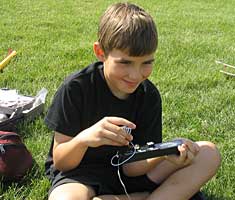 |
Rocket
Cinema presents my efforts to make a really cool rocket video.
My son Henry and I bought our first model rocket in this past June (2004) and quickly got
hooked on both rockets and the idea of strapping a camera along for the
ride. In the months since, we have tried it with a variety of low-power
rocket models, striving for higher altitudes, stabler flights, and gentler
landings. Here is a summary of our progress to date, but bear in mind
that we are still novices in awe of more ambitious and successful
video rocketeers like the Clay
Brothers (don't miss Mercury
Joe) and the Gates
Brothers, among others.
| 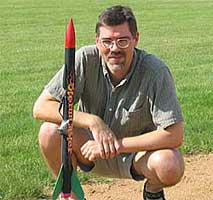 |
Camera
Experienced video rocketeers recommend several cameras, particularly
the X-10 XCAM wireless surveillance camera. We purchased a new product,
Boostervision’s wireless video camera,
for $100 and have appreciated its
tiny size, low weight, and no-tinkering-required qualities. In the field, we
power the receiver with a pack of eight rechargeable AA batteries, and
connect it to a camcorder to record the flight video in realtime.
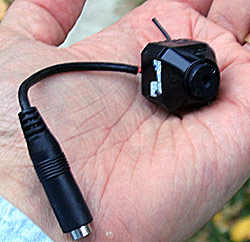 The
videocamera weighs almost nothing, but the required 9-volt battery is
a different matter. Together, the video assembly weighs 2.5 ounches—as much or more than many low-power rocket models.
Thus, our first attempts did
not go very high, roughly 300’ according to Mark Sullivan's rocket
altitude predictor. See the flight logs below for details on the quest
for greater altitudes. The
videocamera weighs almost nothing, but the required 9-volt battery is
a different matter. Together, the video assembly weighs 2.5 ounches—as much or more than many low-power rocket models.
Thus, our first attempts did
not go very high, roughly 300’ according to Mark Sullivan's rocket
altitude predictor. See the flight logs below for details on the quest
for greater altitudes.
Although tiny, the camera is somewhat boxy and we’ve tried several
methods to reduce drag on the rocket. In the end, the simplest measure—a
paper cowling— seems to work well enough. Another option is to put
the camera inside the body tube and use a small mirror to reflect the
view downward, but my craftsman skills were not what they needed to be
to make this work well.
As you can see in the videos, reception is pretty good but not perfect—excessive
vibration tends to break up the signal. Our flights so far have not gone
above 600’, but Boostervision does sell a larger receiving antenna
for longer distances if we ever manage to surpass the standard antenna's range.
Flights
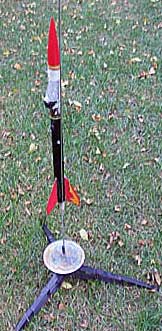 Video
Rocket #1: Estes' Flash Video
Rocket #1: Estes' Flash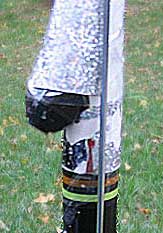
Motor: C6-5
I purchased an Estes Flash for our first video rocket, since it’s
payload tube provided room for the battery. The Flash flights were a great start—exciting enough to hook us on our quest, but not
good enough to satisfy us. They only reached about 350’ altitude,
since the videocam assembly doubled the weight of the rocket. Nevertheless,
the Flash proved a fairly stable video platform, with modest roll
and a great view at apogee.
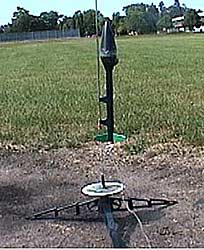 Video
Rocket #2: Custom Rockets’ Elite Egglofter Video
Rocket #2: Custom Rockets’ Elite Egglofter
Motor: C6-5
Theorizing that we needed a superlight launch vehicle, we next purchased a
1 ounce egglofter model from Custom Rockets. The videocam assembly pushed
the weight up the 3.5 ounces , but since this rocket was designed to launch
an egg, I figured it should be powered appropriately. The egg compartment
offered plenty of room for the battery and camera—too much room,
in fact. It was difficult to perfectly center the assembly in the compartment,
causing the rocket to roll rapidly to maintain balance. (Video from these
flights are nearly unwatchable, and so are not included in the clips above.
But we're not the only ones struggling with roll issues—see SpaceShipOne's
September flight video.)
I tried to center the video assembly better, and replaced the stock fins
with larger ones, resulting in somewhat better flights (as shown above).
But the altitudes achieved didn’t seem much better than with the
Flash.
Due to the Elite's skinny body tube, we accidentally packed in too much
wadding several times, leading to an ejection failure and a ballistic
flight plan. On its fourth flight, the motor kicked (ejected itself instead of the parachute, as seen in the second video above) and lawn darted, burying the
nose an inch in the soil, permanently damaging itself.
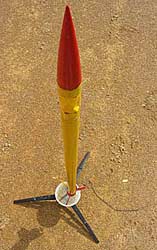 Video
Rocket #3: Fliskits' Nomad Video
Rocket #3: Fliskits' Nomad
Motors: C6-0, C6-5
Seeing that more power was necessary, I purchased the Nomad—a three-stage
rocket from Fliskits. With the videocam assembly in a payload tube made
from extra tubing, we hoped we had enough power to reach a new altitude.
Unfortunately, the two Nomad flights made so far have had staging failures.
The first flight began with a spectacular slow liftoff, due to the extra
weight of the videocam. At roughly 60’, the first-stage motor kicked
(ejected itself)—and took the motor tube with it, but not the rest
of the first stage. The second stage did ignite, shooting the rocket exhaust
through the first stage. But, weighted down with the videocam and the
first stage, the rocket lost stability and veered southward for an abrupt
crash.
After repairing the first stage and sanding the fittings to ensure it
would release properly, we tried again—at a much larger field. This
time, the first stage performed perfectly but the second stage did not
ignite, for another ballistic return and impact. (This is the flight shown
in the video above.) Subsequent research on multi-stage rockets suggests
that they may not be the best vehicle for a videocam’s extra weight (more power from a larger motor
or several clustered motors is more effective),
so future flights with Nomad will be with a groundcam only.
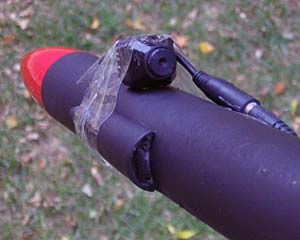 Video
Rocket #4: Estes' Stormcaster Video
Rocket #4: Estes' Stormcaster
Motor: D12 and E6
The Stormcaster is a great rocket: big, solid and powerful. The tube is
wide enough to fit the batter y below the parachute (rather than in the
payload/nose cone section as with previous models). All three flights
with the Stormcaster have been successful, reaching altitudes of about
550’ with safe returns.
Our fourth flight (third Stormcaster video above) was at a Tripoli launch event. We put
an E motor in the rocket in hopes of greater altitude. The first half of the flight was
beautiful—and high—but the chute did not deploy and the rocket came down in
a hurry, buring the tube several inches into the dirt. But the sturdy Stormcaster was
undamaged—we'll fly it again!
As you can see here, packing tape is our best friend, allowing us to strap the videocam onto the rocket in various configurations
with minimal effort and added weight. It ain't pretty, but it's quick, cheap and effective!
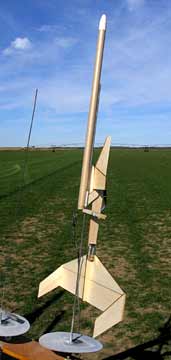 Video
Rocket #5: Edmonds' DeeCee Thunder
Video
Rocket #5: Edmonds' DeeCee Thunder
Motor: D12
This big rocket glider offered a chance for spectacular videos, and nearly fulfilled that
promise. First flight was with the rocketcam taped underneath the canard wing. We launched
it at a Tripoli launch day. The launch was perfect, but the rocket arced over and descended
too far before the D12 motor's five-second ejection delay released the booster. By then, the glider was coming
in fast and low and hit the ground hard, breaking the fuselage in two.
Some balsa and glue fixed it up again, but we should have learned our lesson regarding
the motor. Instead, we launched it again with a D12-5. This time we strapped the camera on
the wingtip for a spectacular view encompassing the rocket motor itself and
most of the glider. The brief flight was dramatic but ill-fated. Unstable from the rocketcam
and counterweight, the rocket-glider rolled and veered away, crashing in a tree. Dusk was coming
and we could not spot it before night fell. Somewhere up in that tree, the camera kept transmitting
video until the battery died. We're still hoping
that it will come
down in a wind and we can retrive it.
Next…
We are
winding down our rocket video efforts for the year, and still hoping to retrieve the
rocketcam. We have a few E motors left and with some luck will use them with the
Stormcaster Rocketcam next spring...
David T. Schaller, St. Paul, MN
Contact me
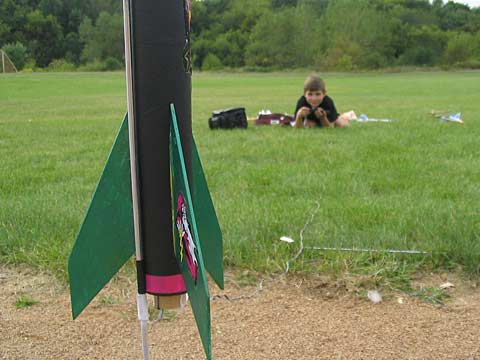
Copyright 2004 David T. Schaller |


 The
videocamera weighs almost nothing, but the required 9-volt battery is
a different matter. Together, the video assembly weighs 2.5 ounches—as much or more than many low-power rocket models.
Thus, our first attempts did
not go very high, roughly 300’ according to Mark Sullivan's
The
videocamera weighs almost nothing, but the required 9-volt battery is
a different matter. Together, the video assembly weighs 2.5 ounches—as much or more than many low-power rocket models.
Thus, our first attempts did
not go very high, roughly 300’ according to Mark Sullivan's  Video
Rocket #1: Estes' Flash
Video
Rocket #1: Estes' Flash
 Video
Rocket #2: Custom Rockets’ Elite Egglofter
Video
Rocket #2: Custom Rockets’ Elite Egglofter Video
Rocket #3: Fliskits' Nomad
Video
Rocket #3: Fliskits' Nomad Video
Rocket #4: Estes' Stormcaster
Video
Rocket #4: Estes' Stormcaster Video
Rocket #5: Edmonds' DeeCee Thunder
Video
Rocket #5: Edmonds' DeeCee Thunder